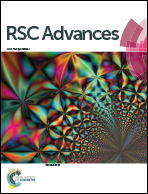Synthesis of highly fluorescent Cu/Au bimetallic nanoclusters and their application in a temperature sensor and fluorescent probe for chromium(iii) ions†
Abstract
Bimetallic nanoclusters (BNCs) have attracted great attention due to their cooperative electronic, optical, and catalytic properties. Here, a novel one-step synthetic method is presented to prepare highly fluorescent bimetallic copper–gold nanoclusters (Cu/Au BNCs) in ambient conditions by using glutathione (GSH) as both the reducing agent and the protective layer preventing the aggregation of the as-formed NCs. The resultant Cu/Au BNCs are uniformly dispersed, with an average diameter of 1.5 nm, and it exhibits emission at 450 nm with excitation at 380 nm. Interestingly, the fluorescence signal of the Cu/Au BNCs is reversibly responsive to the environmental temperature, and it shows good sensitivity in the range of 20–70 °C (F = −23.96T + 3149.2 (R = 0.94)). Furthermore, it was found that the fluorescence of Cu/Au BNCs was quenched selectively by Cr3+, and a detection method was further developed with detection linear range from 50 nM to 1 mM (F = −174.85[Cr3+] + 1686.69 (R = 0.98)) and high sensitivity (LOD = 10 nM, S/N = 3).



 Please wait while we load your content...
Please wait while we load your content...